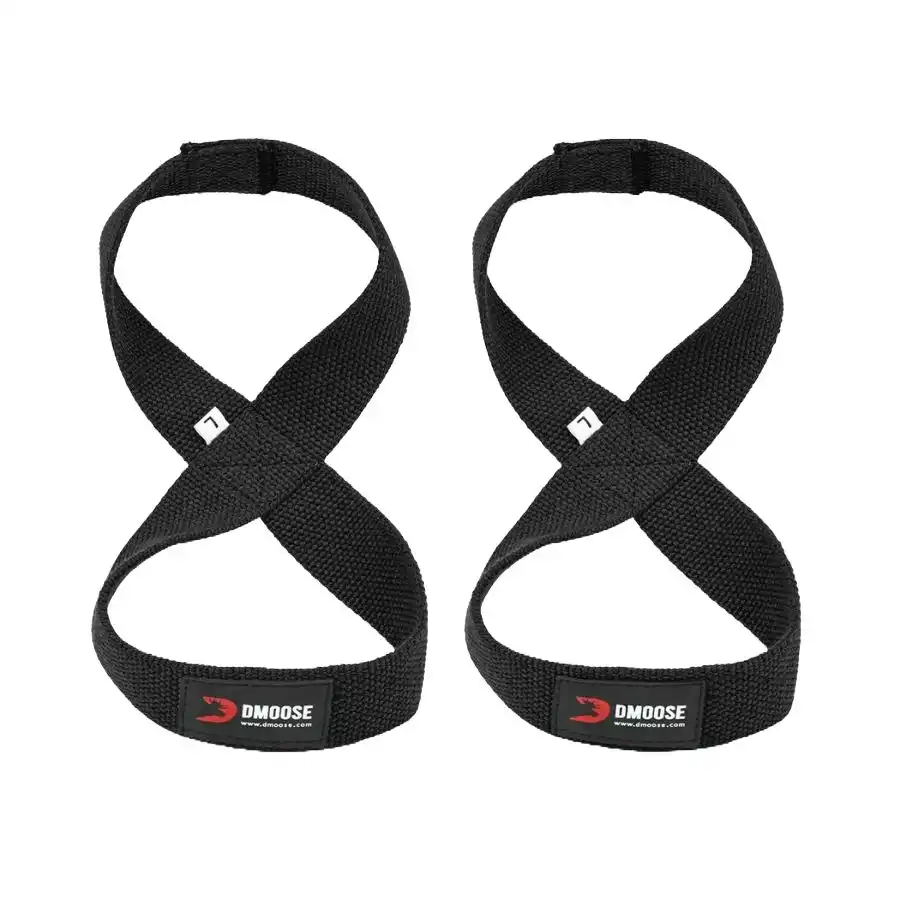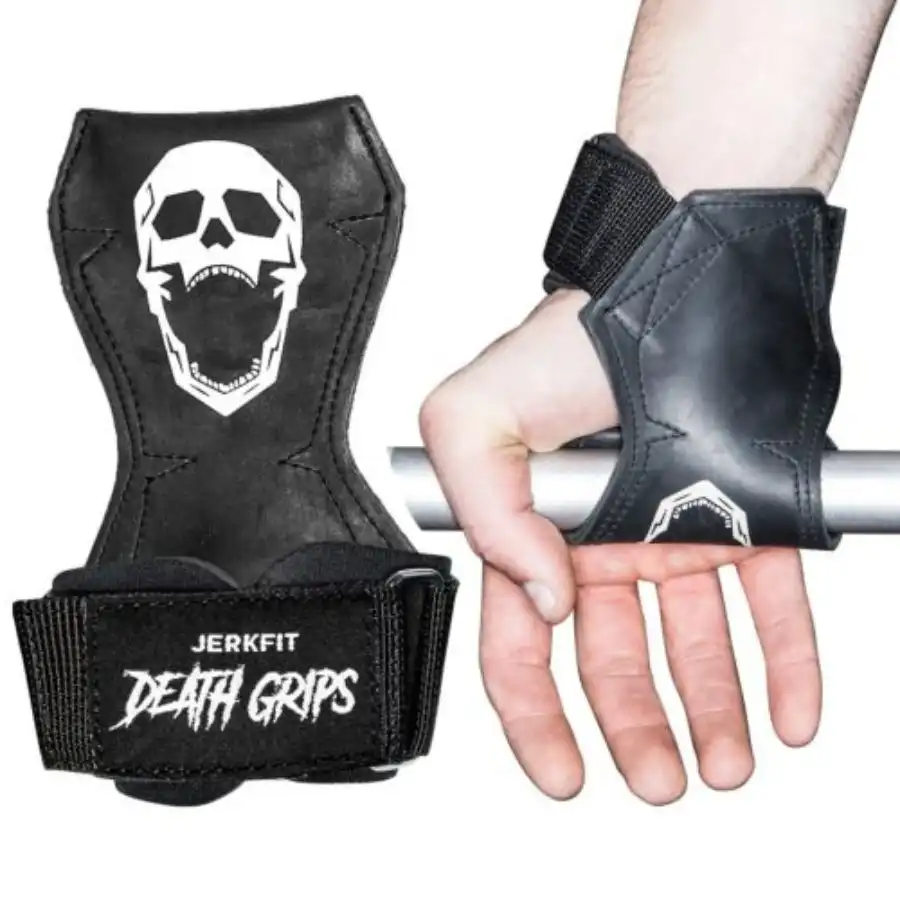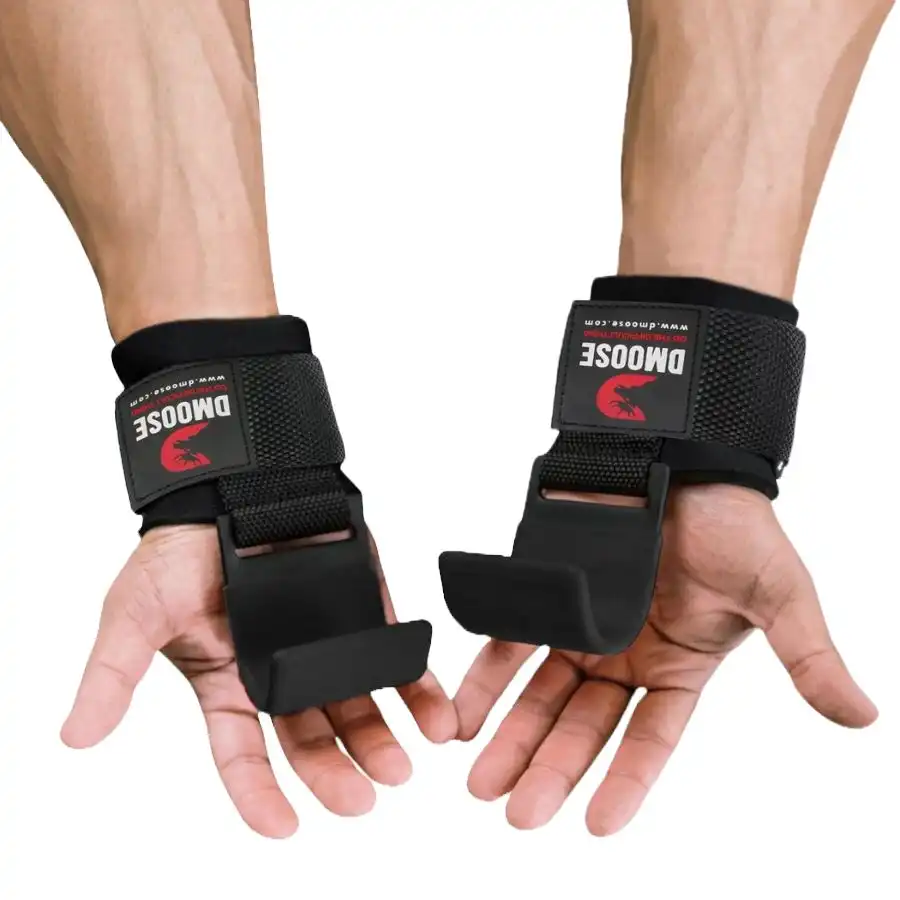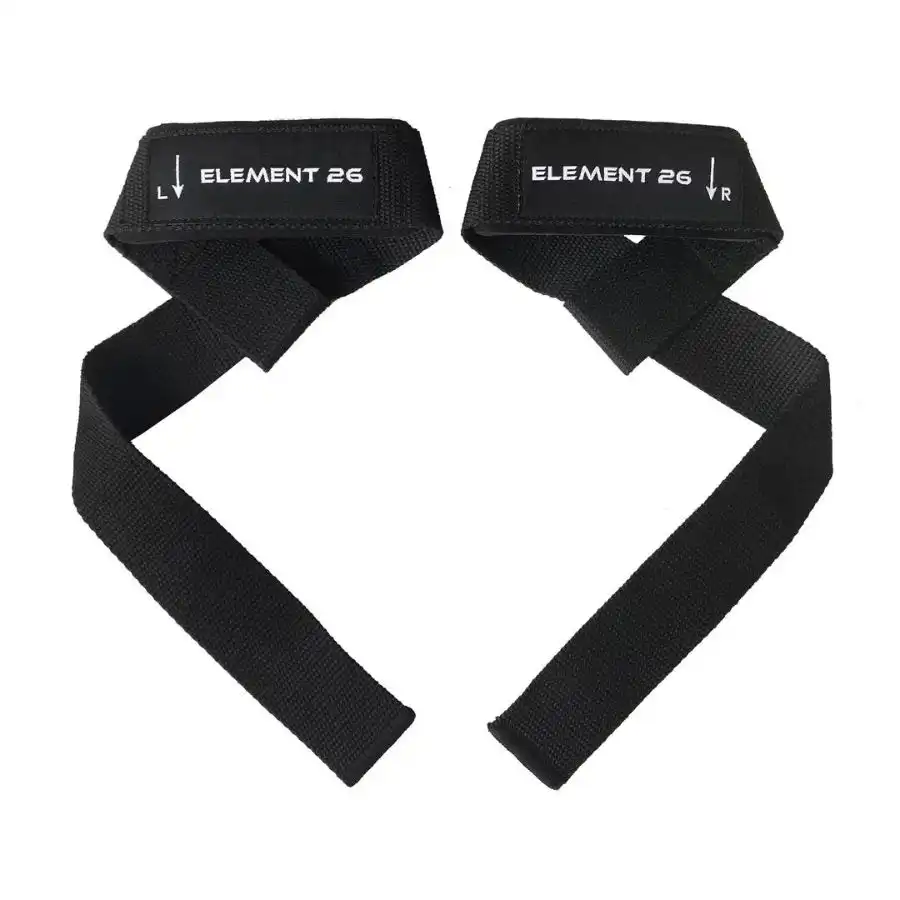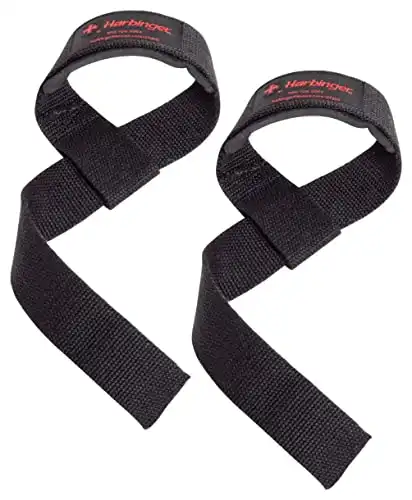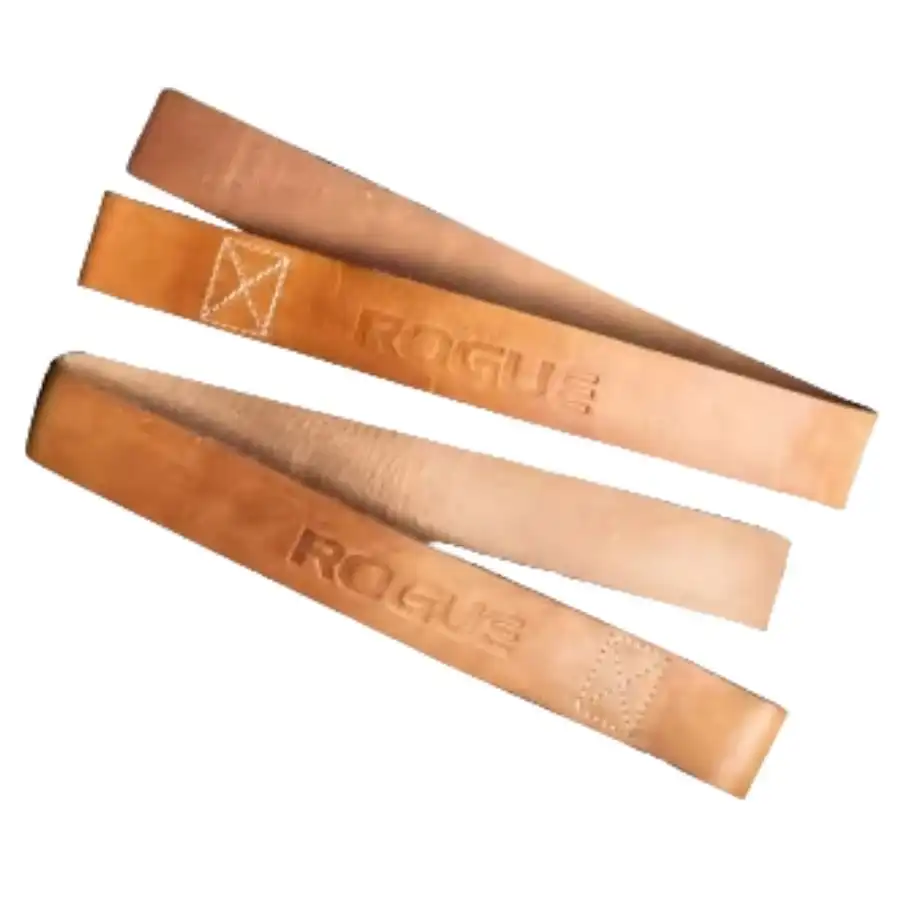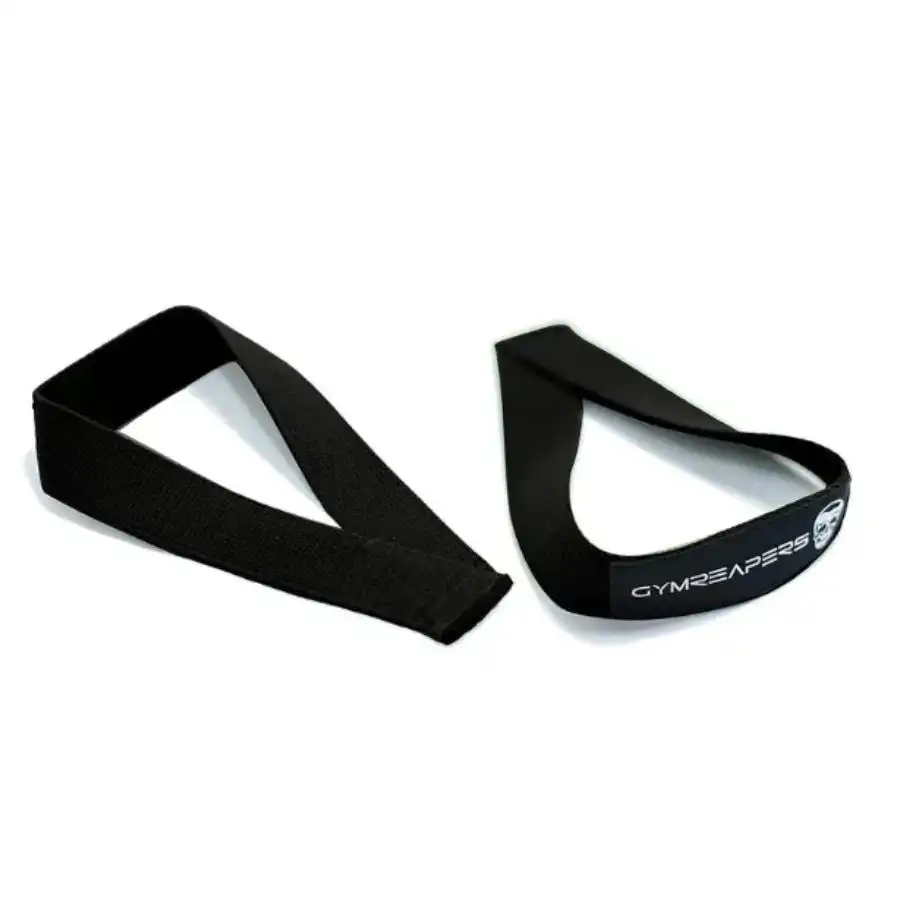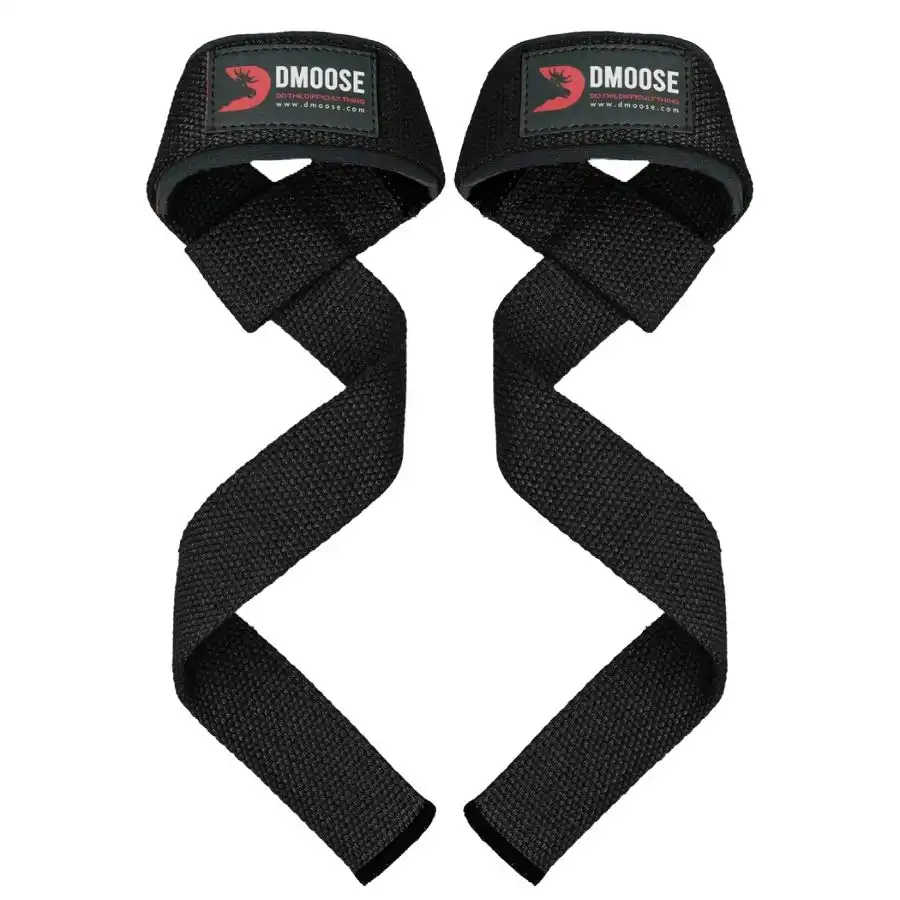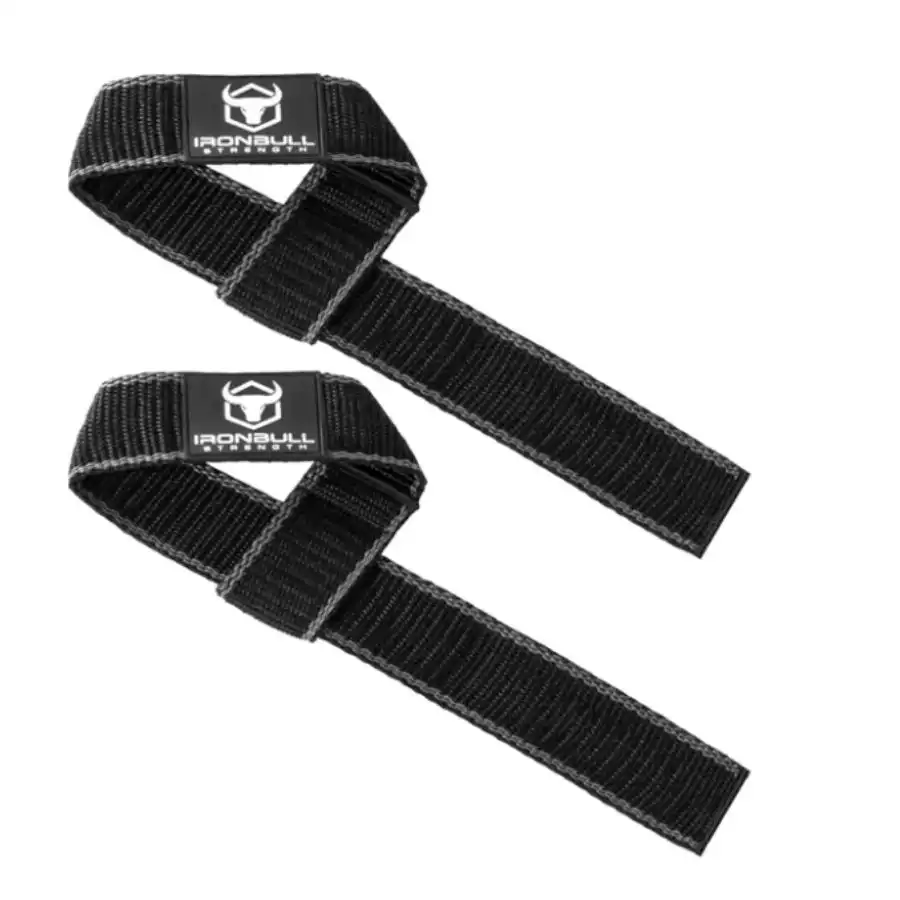From protecting your hands to lifting heavier weights, the solution to finding the best lifting straps is to just randomly pick a pair and get back to your workout, right? Wrong. Straps are way more complicated than they appear. From weight capacity to color and material, each of the five different styles has its own best use cases….
The post Best Lifting Straps for Powerlifting, Olympic Weightlifting, and More (2023) appeared first on Breaking Muscle.
From protecting your hands to lifting heavier weights, the solution to finding the best lifting straps is to just randomly pick a pair and get back to your workout, right?
Wrong.
Straps are way more complicated than they appear. From weight capacity to color and material, each of the five different styles has its own best use cases. We’re here to help you decide which ones will suit you best.
How We Chose the Best Lifting Straps
The Breaking Muscle team features a roster of powerlifters, Olympic weightlifters, CrossFitters, strength and conditioning coaches, and certified personal trainers. Across the board, we’ve tested over a dozen lifting straps from various brands and evaluated their durability, grippiness, and how connected we felt to the bar when lifting. Down below, you’ll find our top choices to help you figure out which straps are the best fit for you and your training style.
Our Top Picks for the Best Lifting Straps
- Best Lifting Straps Overall: Iron Bull Strength Unleash Lifting Straps
- Best Figure 8 Lifting Straps: DMOOSE Figure 8 Lifting Straps
- Best Lifting Straps for Deadlifts: Jerkfit Death Grips
- Best Lifting Straps With Hooks: DMOOSE Weightlifting Hooks
- Best Lifting Straps for Small Wrists: Element 26 Weightlifting Straps
- Best Lifting Straps on Amazon: Harbinger Padded Cotton Lifting Straps
- Best Leather Lifting Straps: Rogue Treated Leather Straps
- Best Olympic Lifting Straps: Gymreapers Olympic Lifting Straps
- Best Budget Lifting Straps: DMOOSE Lifting Straps
- Best Lifting Straps for Powerlifting: Iron Bull Strength Premium Lifting Straps
Best Lifting Straps Overall: Iron Bull Strength Unleash Lifting Straps
Iron Bull Strength Unleash Lifting Straps
4.5
- Material: Nylon
- Style: Traditional
- Length: 24 inches
- Padding: 5mm neoprene
Pros
- Heavy-duty nylon construction
- Adjustable to any wrist size
- Soft neoprene padding for wrists
- Three colors available: black, green, and red
Cons
- Less comfortable and absorbent than cotton
- Using traditional straps takes practice
The Iron Bull Strength Unleash Lifting Straps are our top pick overall. They’re made from high-quality nylon, a durable and resilient material that doesn’t stretch or tear easily. This means they can withstand heavy loads and intense workouts. And unlike cotton or leather straps, nylon straps don’t tend to fray or rot over time. These straps will last you for years of lifting without losing their shape or strength.
Thanks to their traditional “lasso” design, you can tighten or loosen them as you wish, depending on the thickness of your wrists and the diameter of the bar. This ensures a secure and comfortable grip on the bar, preventing any slippage or movement.
The Unleash Lifting Straps have soft and thick neoprene padding that cushions your wrists and prevents any abrasion or irritation. Neoprene is a synthetic rubber, the same material in almost all the best knee sleeves, that is flexible and supportive. It provides a smooth and soft surface for your wrists, reducing some of the pressure while distributing the weight more evenly.
Unfortunately, the Unleash straps are less comfortable than cotton straps, especially in hot and humid conditions. They’re made from nylon, a synthetic material that doesn’t breathe well, which traps heat and moisture. They also have poor absorption, which can cause a layer of sweat to build up on your wrists and affect the placement of your straps and comfort. Sweat can cause bacteria and odor to build up on your straps, which can be unpleasant and unhygienic. You’ll need to wash your nylon straps regularly to keep them clean and fresh.
These straps are traditional (lasso) lifting straps, so you loop them around your wrists and then wrap them around the bar several times to create a tight and secure connection. However, this process requires some skill and practice. At first, it will be awkward and time-consuming, but after a while, you should get the hang of it.
RELATED: Weight Lifting Straps: What They Are, When and Why to Use Them
Best Figure 8 Lifting Straps: DMOOSE Figure 8 Lifting Straps
DMoose Figure 8 Straps
4.2
- Material: Cotton
- Style: Figure 8
- Length: Length isn’t listed, but they are 6 to 7.5 inches wide
- Padding: None
Pros
- Easy-on and easy-off the bar
- Comfortable cotton material
- Three sizes available: S, M, and L
- Five colors available: black, red-black, navy blue, green, American (red-blue)
Cons
- No padding for wrists
- Using Figure 8’s can feel unnatural
- Require correct size to function correctly
The main advantage of Figure 8 straps is that they’re easy to use. Simply loop one end around your wrist, bring your hand close to the bar, and feed your hand through the other loop. Bring your hands inwards to grab the bar for the straps to become tight, creating a secure grip that won’t slip or loosen during lifts. To remove them, just reverse the process and slide them off your wrists — no need to fumble with long straps again!
The DMOOSE Figure 8 Lifting Straps are made of high-quality cotton that’s soft and durable. Cotton is breathable and doesn’t irritate your skin or cause excessive sweating, so you’ll have a better grip whether you’re lifting a barbell, kettlebell, or axle bar.
They’re also machine-washable, so you can keep them clean and fresh. The DMOOSE Figure 8 Lifting Straps offer three sizes (small, medium, or large) to suit your wrist and hand size. The size chart on their website is clear and will help you find the right fit.
The DMOOSE Figure 8 Lifting Straps don’t have any padding or cushioning for your wrists. This means they might dig into your skin and cause discomfort or bruising, especially if you lift heavy weights or use them for high-rep sets. I’ve even seen some elite-level lifters end up with small skin tears because they’re deadlifting massive weights. If you have sensitive wrists or prefer more comfort, you may want to look for straps with wrist padding, like the Element 26’s.
Remember how they’re easy to use? Well, that’s after you learn how to use them. Most beginners find figure 8 straps awkward to use at first due to incorrect use. Even when used properly, they can still feel unnatural as the load is held outside your hands instead of in line with them. As a result, you may need some time to get used to them, especially if you’re accustomed to traditional straps.
Finally, figure 8 straps aren’t a one-size-fits-all. They require the correct size to function correctly, so you won’t get the optimal grip and support from the straps if you choose a size that is too big or too small. Make sure to measure your wrist and hand size carefully and follow the size chart on their website before buying.
Best Lifting Straps for Deadlifts: Jerkfit Death Grips
Pros
- Fast to apply and remove
- Offers a strong grip
- Durable PVC rubber material
- Three sizes available: S, M, and L
Cons
- Thickness can take getting used to
- Higher risk of loose threads
- More expensive
Our Breaking Muscle product tester found the Jerkfit Death Grips fast and easy to use. Unlike other straps that require you to wrap them around the bar multiple times, the Death Grips attach to your wrist with a velcro strap, and then you wrap the rubber flap around the bar — trapping the bar between the grips and your palms. When used on deadlifts, they avoid the hassle of fiddling with a longer strap during your setup. They also save time, especially when used for deadlifts in timed workouts like those seen in CrossFit.
When they tried them in a workout, our team member was impressed by the grip. They felt connected to the bar during their deadlifts and pulled heavy weights that they would have felt slipping without them. When used on pull-ups and dumbbell exercises, they found the grips held up well without slipping. This is due to their unique PVC rubber construction and neoprene padding. During the entire test, their comfort surprised our product tester, and they loved how intuitive they were to use.
One of the drawbacks of the Jerkfit Death Grips is that they can take some time to get used to, especially if you’re not familiar with using lifting straps. The Death Grips are a little bulky because of the neoprene pad, so they can initially feel awkward. Compared to traditional lifting straps, the pad size is larger with more stitching, resulting in a higher risk of loose threads than other straps. You may need to trim or burn off any loose threads that you notice on your straps to prevent them from getting worse.
The other downside of the Jerkfit Death Grips is the cost. At the time of writing, the Death Grips cost $39.95 per pair. This price is more than double that of other quality straps in this article, like the DMOOSE budget-friendly straps. While the Death Grips offer a lot of value and quality for their price, they may not be affordable or worth it for everyone.
RELATED: Best CrossFit Shoes for Flat Feet, Wide Feet, and More (2023)
Best Lifting Straps With Hooks: DMOOSE Weightlifting Hooks
DMoose Lifting Hooks
3.8
- Material: Rubber-coated stainless steel hooks, nylon strap
- Style: Hooks
- Length: 3.7 inches
- Padding: 8mm neoprene
Pros
- Extremely easy and quick to use
- Hooks fit barbells, pull-up bars, cable machines and more
- Wide and deep hooks for secure lifting
- Thick padding for wrist comfort
- Six colors available: black, red, blue, green, pink, grey
- About $30
Cons
- 600-pound weight limit
- Thick wrist padding might cause sweating
- Fixed hook won’t fit all hand sizes
Unlike other lifting straps that require you to wrap them around the bar multiple times, these hooks are nearly effortless to apply. Put them on your wrists, tighten the velcro strap, hook them onto the bar, and voilà!
Straps this easy to use saves you time and avoids the hassle of resetting your straps, especially when switching between different exercises or weights. For ease and speed, I find hooks are better than any other strap type while not interfering much with your grip or wrist mobility.
These hooks are versatile and can be used for various types of implements. They’re suitable for barbell lifts such as deadlifts, shrugs, or rows, as well as using them on pull-up bars. They play nice with cable machine attachments, and one customer even mentioned they use them on their rowing machine handles to combat grip fatigue.
RELATED: Best Rowing Machines for Beginners, Small Spaces, Seniors, and More
I’m pleasantly surprised by their construction. The actual hooks of the Weightlifting Hooks are made from reinforced stainless steel with a non-slip rubberized coating. This means they should have no problem handling weights up to the listed capacity.
They’re 3.3 inches wide and have a deep curve that ensures a stable and secure grip on the bar. Unlike narrow or shallow hooks, the DMOOSEs will prevent the bar from tipping or slipping out of your hands, which could cause injuries or, at the very least, compromise your form.
These hooks have a maximum weight capacity of 600 pounds, which might be a limitation for some advanced lifters who want to lift heavier weights. If you exceed this limit, you risk damaging the hooks or injuring yourself — consider the best lifting straps for powerlifting from Iron Bull Strength instead.
The Weightlifting Hooks might cause your wrists to sweat more than usual, especially in hot or humid conditions. The thick neoprene padding is extra-wide to cover your wrist area and the lower part of your palm, but this results in a large non-breathable area of skin. Further, the velcro strap must be cinched extra tight to avoid getting pulled off from heavy weights resting in the hooks. While it’s unlikely that either of these will cause a structural issue with the hooks, the excessive sweat can make them uncomfortable or unhygienic unless you wash them often.
Unfortunately, the hooks are fixed in place and don’t have any adjustment options. This means that they might only fit average hand sizes correctly. For those with extra small or large hands, the hooks might be too close to your fingertips or wrists, respectively. In turn, this can negatively affect your grip strength or comfort level.
Best Lifting Straps for Small Wrists: Element 26 Weightlifting Straps
Element 26 Weight Lifting Straps
3.5
- Material: Cotton
- Style: Traditional
- Length: 23 inches
- Padding: 5mm neoprene
Pros
- Lasso-style is great for small wrists
- 23-inch length for secure lifting
- Comfortable neoprene padding for wrists
- Left and right side indicators
Cons
- Left and right indicators are technically redundant
- Cotton is weaker than nylon
- Straps only come in black
The defining feature of the Element 26 Weightlifting Straps is the traditional lasso style, meaning they have a closed loop at one end where the free end feeds into them. This strap style is great for small wrists because it allows you to adjust the size until the strap matches your preference. You can also easily switch between different exercises without re-adjusting them. Overall, lasso-style straps are more secure and stable than other straps, such as Olympic lifting or hooks.
Another pro of the Element 26 Weightlifting Straps is that they’re 23 inches long. This length is ideal for lifting straps for a couple of reasons. First, it makes it easier to wrap the straps with a single hand, especially your non-dominant side. Second, the 23-inch length is compatible with a wider range of barbells; axle bars have a noticeably larger diameter than Olympic barbells, so the longer material gives you get more wraps around the bar for a more secure grip — this is helpful for those with smaller wrists and hands that would otherwise struggle with thicker bars.
The Element 26 Weightlifting Straps have comfortable neoprene padding inside the loop around your wrist. Neoprene is a soft and flexible material that provides cushioning and support for your wrist, reducing the pressure that can cause discomfort and pain to your wrists during heavy lifting.
One of the cons of the Element 26 Weightlifting Straps is that they have left and right indicators on the loop around your wrist. These indicators are supposed to help you put on the straps correctly, but they’re actually redundant and unnecessary. Lasso-style straps have a closed loop on one end, and whether the free end is fed through the left or right side determines which hand they belong on. Since there is no difference between the left and right straps, except for the indicator, this feature is basically just a gimmick that adds little value to the straps.
Another con of the Element 26 Weightlifting Straps is that they are made of cotton, which is weaker than nylon. Nylon is a synthetic material with higher tensile strength and durability than cotton, so it can withstand more weight and stress without breaking or tearing. Cotton straps, on the other hand, can fray or snap after prolonged use or exposure to moisture. Cotton straps are also more prone to shrinking or stretching after washing or drying, affecting their fit and performance.
Finally, the Element 26s only come in black. Black is the standard color for lifting straps, but it can also be dull. Some lifters may prefer colorful or vibrant options to match their personality or style. Black straps can also be more challenging to identify in a crowded gym or locker room because they all look similar. More color choices would make the product more appealing and attractive to a broader range of customers.
Best Lifting Straps on Amazon: Harbinger Padded Cotton Lifting Straps
Harbinger Padded Cotton Lifting Straps
4.0
- Material: Cotton
- Style: Traditional
- Length: 21.5 inches
- Padding: “Neotek” (neoprene)
Pros
- 4.7/5 rating from over 27,000 customers
- Excellent price & perks for Amazon members
- Comfortable and soft material
Cons
- Loose threads upon receiving
- Straps can be a little stiff
- Higher risk of tearing on aggressive bars
The Harbinger Padded Cotton Lifting Straps have a 4.7 out of 5 rating from over 27,000 customers on Amazon, and they’re also rated #2 in the “Exercise Straps” category. That means tens of thousands of people have tried and loved these straps, so you can trust their quality and performance. But let’s not forget about their price. At the time of publishing, they cost only $9.97 — a steal compared to other lifting straps on the market. Plus, if you’re an Amazon Prime member, you can enjoy free shipping and an excellent return policy.
They impressed our Breaking Muscle team member with their softness and comfort. Being made from cotton, the straps felt soft in the hands and offered extra wrist cushioning with their “Neotek” padding (essentially just neoprene). Our tester also noticed that the padding helps absorb sweat and moisture, so your hands will stay drier during your workouts, and it’ll be easier to keep a better grip.
Unfortunately, when our product tester opened the bag, they were surprised that the Harbingers had some loose threads and burs. The straps performed without any issues for a few weeks during barbell workouts, but these imperfections made our tester a bit concerned about how the straps would do after a year.
According to a few customers, the straps can sometimes feel stiff when first using them, making it harder to wrap them around the bar and tighten them around your wrist. However, we didn’t find this to be the case. If you run into this issue, the problem will subside as the straps are used because they’ll become more flexible and pliable.
Lastly, some users reported that the straps broke with heavy weights, which was extremely rare. This might be due to a combination of the straps being 100 percent cotton and being used on barbells with aggressive knurling. Cotton is a weaker material than nylon, so these straps are more prone to fraying or snapping over time — especially if they’re used in humid conditions. While the risk of these straps breaking is extremely low, and our product tester (who lifted 315 pounds with them) didn’t experience any issues, consider more robust nylon straps if you’ll be lifting serious weights.
Best Leather Lifting Straps: Rogue Treated Leather Straps
Rogue Treated Leather Straps
3.5
- Material: Leather
- Style: Traditional
- Length: 24 inches
- Padding: None
Pros
- Made in the USA
- Extra-strong stitching
- Classic look and feel
- Top-tier Rogue Fitness quality
Cons
- Less comfortable initially
- Leather can stain
- Slippier than cotton or nylon
The Rogue Treated Leather Straps are our top leather choice because it’s hard to beat the quality and craftsmanship of products made in the USA. These straps are crafted from 100 percent genuine premium belly leather, known for its balance of soft pliability and reliable durability. With the local manufacturing, product material, and brand, you can trust that these straps will last a long time and perform well in any lifting situation.
One of the most critical features of any lifting strap is the stitching. If the stitching is weak or poorly done, the strap can tear or unravel quickly. Double-stitching used to be a step above and an excellent way to increase the longevity of sewn products, but Rogue has used box-stitching on these straps, a technique that reinforces the seams and minimizes fraying. The stitching is also done with heavy-duty nylon thread, which adds to the strength and durability of the straps.
In terms of material, leather is an all-time classic. One of our product testers at Breaking Muscle has similar lifting straps made from genuine leather. They’re a few years old and are much loved. They’ve found that the feel of leather is second to none, and as you use them, they’ll mold to the shape of your hands and wrists — giving you a truly bespoke pair of straps. The leather also has a natural texture and color that gives these straps a timeless and elegant appearance.
All leather products take some time to break in, and these straps are no exception. When you first receive them, they might feel stiff and rough on your skin — this is normal. You can roll them up and unroll them a few times to help the break-in process, but we’ve found they take a couple of weeks of regular use to soften for maximum comfort on the back of your hands. Remember, good things take time!
One downside of leather is that it can absorb sweat, dirt, and other lovely substances over time. This can cause the leather to change color or develop marks that might look unappealing. Our staff member noticed some stains on theirs but appreciated the added character to the leather. If you care about the aesthetics of your straps, consider cleaning and treating them regularly or avoiding them altogether and going for a nylon strap instead.
Lastly, leather can be slippier than cotton or nylon. This can affect your grip on the bar, especially if your hands are sweaty or oily. Just place the rough side of the leather straps against the bar. This texture will dig better into the knurling and give more friction for the best grip possible.
Best Olympic Lifting Straps: Gymreapers Olympic Lifting Straps
Gymreapers Olympic Lifting Straps
3.8
- Material: Cotton
- Style: Olympic lifting
- Length: 8.5 inches
- Padding: None
Pros
- Tear-drop design for Olympic weightlifting
- Reinforced triple-stitching
- Lifetime replacement guarantee
- Four colors available
Cons
- No padding for wrists
- Less secure than traditional straps
The main benefit of the Gymreapers Olympic Lifting Straps is that they’re specifically designed in a tear-drop shape for Olympic weightlifting. They’re shorter than traditional straps, so they wrap around the bar less. This means they help with your grip, but if you need to bail a snatch or clean and jerk, they’ll release in time to safely separate yourself from the bar. This can prevent devastating injuries from longer straps that wouldn’t detach from the bar in time.
Another benefit of these straps is their reinforced stitching. The seams of most straps are only double-stitched, resulting in a weaker area that could start to unravel over time. However, these Olympic lifting straps from Gymreapers are triple-stitched — making loose threads extremely unlikely to ever happen. This means you can get a secure grip around the bar, with the peace of mind that your straps will endure over time.
One of the best things about these straps is that they come with a lifetime replacement guarantee. If your straps ever break or wear out, Gymreapers claims you can get a new pair for free. This is a rare and generous offer that shows how confident the company is in its product quality and customer satisfaction. With these Olympic Weightlifting Straps, you can rest assured that you’re getting a reliable and long-lasting training tool to help you achieve your Oly lifting goals.
However, these straps also have some drawbacks, such as a lack of padding on the wrist area, making them less comfortable. As a result, you might experience chafing or bruising on your wrists until you get used to them. If you prefer more cushioning and comfort, consider looking for padded straps instead, like the Iron Bull Strength Unleash Lifting Straps.
Another downside of these straps is that they’re less secure than traditional straps. Of course, this is intentional because they’re made for Oly lifting — but it’s still worth noting. Since they are shorter, they can come undone more easily than traditional lasso straps. This is done on purpose to allow for quick release in case of emergency, but it also means that you might lose your grip if you’re not careful.
Best Budget Lifting Straps: DMOOSE Lifting Straps
DMoose Lifting Straps
3.5
- Material: Cotton
- Style: Traditional
- Length: 24 inches
- Padding: 4mm neoprene
Pros
- Budget-friendly price
- Fits all wrist sizes
- Comfortable to use
- Nine colors available (Black, American, Black Silicon, Emerald Green, Military Green, Red-Black, Magenta Pink, Red Silicon, Navy Blue)
Cons
- Grippy silicone texture isn’t for everyone
- Double-cross stitching only
- No weight capacity listed
The standout feature of the DMOOSE Lifting Straps is the price. At the time of writing, these retail for $15 after being marked down from $17 — not quite as cheap as the Harbinger Padded Cotton Lifting Straps, but close.
One of the best features of these straps is that they fit all wrist sizes. The straps have a closed-loop design, so you can tighten them like a lasso around your wrists. This allows you to adjust the fit according to your wrist size and comfort level. You don’t have to worry about the straps permanently being too loose or tight, as you can easily adjust them to your liking.
These straps are also incredibly comfortable, featuring a 4mm padding on the inside for cushion and to prevent chafing. The cotton material is also soft and breathable, which keeps your hands cool and dry. At 24 inches long and 1.5 inches wide, they give you enough length and width to wrap around the bar securely.
However, these straps aren’t perfect—one of their main cons is the grippy silicone texture. When a Breaking Muscle team member used a nearly identical pair of these straps from another brand, they found it hard to tighten and loosen the straps due to the sticky nature of the silicone texture. Our product tester also disliked the feeling of the raised texture in their hands when they gripped the bar with the straps on. This is a matter of personal preference, though, and some people may actually prefer the silicone bumps.
Another downside of these straps is that they only have double-crossed stitching, which is weaker than box stitching. Box-stitching is a more secure method of stitching that creates a square-shaped pattern on the strap with an “x” through the box. This makes the strap more resistant to tearing and fraying. The DMOOSE Lifting Straps have double-crossed stitching, which is better than single stitching but still not as sturdy as box stitching.
Sadly, these straps don’t have a weight capacity listed on their website or product page. This means you don’t know how much weight these straps can safely handle. It would be helpful if the company provided details on how much weight these straps can support. Can they hold 200 pounds, 500 pounds, or 1,000 pounds? This would give customers more transparency when considering these straps and ensure they aren’t asking the world from budget-friendly lifting straps.
Best Lifting Straps for Powerlifting: Iron Bull Strength Premium Lifting Straps
Iron Bull Strength Premium Lifting Straps
4.0
- Material: Nylon
- Style: Traditional
- Length: 25 inches
- Padding: None
Pros
- Extra-strong nylon material
- Powerlifting-tailored design
- No padding
- Reputable brand
Cons
- Less comfortable on wrists
- No weight capacity listed
- Doesn’t absorb sweat well
If you’re looking for a pair of lifting straps that can handle the heaviest weights and the most demanding workouts, consider the Iron Bull Strength Premium Lifting Straps.
These straps are made of extra-strong nylon material, which is ideal for powerlifting because nylon is one of the most robust materials for lifting straps, beating out cotton any day. Robust, heavy-duty nylon improves grip strength on every pulling movement and can be used on barbells, dumbbells, kettlebells, or any cable machine.
Iron Bull Strength claims these are “Level 4” strength, but I couldn’t find a scale or explanation of what this actually means on their website. In contrast, their Figure 8 straps, which are also a Level 4 strength, have a 1,000+ pound capacity.
Iron Bull Strength is well known in the powerlifting and strength training communities for reputable products, so I doubt these straps will fail with regular use. However, I was surprised to see that as their premium lifting straps, they do not have a weight capacity listed. This makes it hard to compare them with other brands or models and also raises some questions about their durability and safety.
The design of these straps is well-suited for powerlifting. They have a two-inch width, so those elite powerlifting records you’ll be lifting with them will be dispersed better across your hands — resulting in less bruising and skin tears. I was delighted they have double-stitching to ensure the likelihood of loose threads is as low as possible, a must for straps that will be pushed to the limit.
One thing that sets these straps apart is that they have zero padding. This is done intentionally to guarantee a maximum grip and authentic feel during your most intense lifts.
Some lifters prefer this style of straps, believing that padding reduces the contact between the hand and the bar and thus compromises the grip. However, this also means these straps are less comfortable on the wrists and will take some getting used to. If you have sensitive skin or are prone to bruising, consider looking for another option.
Unlike cotton, nylon does not absorb sweat as well, which can make the straps slippery and uncomfortable after a long session. This can also affect the hygiene and odor of the straps, as sweat can accumulate and cause bacteria growth. To prevent this, wash your straps regularly and let them air dry completely before using them again.
Different Types of Lifting Straps
There are many kinds of lifting straps available on the market, each with its advantages and disadvantages. Here are some of the most common ones:
Traditional/Lasso Straps
These are the simplest and most widely used types of lifting straps. Consisting of a long piece of fabric with a closed loop, the free end is fed through the loop, around your wrist, and then wraps around the bar several times. This makes them easy to use and adjust, and they provide a secure grip on any bar because they act like a lasso. However, they can also be challenging to release quickly, which can be problematic if you need to bail out of a lift or switch between exercises.
Olympic Lifting Straps
These are similar to traditional straps, but they have a shorter length and a closed tear-drop shape. They’re designed for Olympic weightlifting, where you need to quickly release the bar after completing a snatch or a clean and jerk. They are also suitable for explosive movements like high pulls or power cleans.
Figure 8’s
These straps form a figure-eight shape. They are straightforward to put on and take off, and they provide a very tight grip on the bar — so much so that you can let go completely and they should stay on. They’re ideal for heavy deadlifts or shrugs, where you don’t need to worry about dropping the bar or changing your grip. However, they’re often misused by beginners so they can take some practice to use correctly.
Hooks
Attached to a wrist strap, these metal hooks grab onto the bar to take pressure off your grip and allow you to focus entirely on your working muscles. They’re great for people with weak or injured hands or wrists, or who want to lift very heavy weights without ever taxing their grip strength. However, they can also be more expensive, bulky, and unsafe if they break or slip off the bar.
Grips
These are rubber or silicone pads that stick to your palms and create friction with the bar. They are similar to gloves, but they only cover your palm. Grips are ideal for people who don’t like the feeling of straps or hooks or who want to make their setup fast. However, they can also wear and lose their stickiness quickly compared to other types of straps.
What Are the Benefits of Using Lifting Straps?
Lifting straps can help you in several ways when you’re working out. Here are some of the main benefits:
Reduced Grip Fatigue
One of the most significant limitations when lifting heavy weights is your grip strength. Your hands and forearms can tire before your target muscles do, preventing you from completing more reps or adding more weight. Lifting straps can help you overcome this by taking some of the load off your hands and transferring it to your arms and shoulders.
RELATED: The Best Shoulder Workouts for More Muscle, For Strength, For Beginners, and More
Ability to Hold More Weight
Another benefit of lifting straps is that they allow you to hold more weight than you usually could with your bare hands. This can help you break through plateaus and challenge yourself with heavier loads. Lifting more weight can also stimulate muscle growth and strength gains since your grip no longer limits you.
Protection Against Rips and Tears
Lifting heavy weights can damage your skin, especially if you have rough, dry, or heavily calloused hands. Lifting straps can protect your hands from getting ripped or torn by creating a barrier between your skin and the bar. This can also prevent infections and reduce pain and inflammation.
When Should You Use Lifting Straps?
Lifting straps can be a valuable tool for enhancing your training, but they shouldn’t be used all the time or for every exercise. Here are some guidelines on when to use them:
- Use them sparingly: Lifting straps should not replace your baseline grip strength. You should still train your grip regularly using the warm-up sets of your exercises. Avoid using straps for every set or every workout, and only use them when you really need them, like when you’re going for a personal record, doing high-rep sets, or working on weak points.
- Use them strategically: Lifting straps shouldn’t be used for every exercise. Use them only for exercises that involve pulling movements, such as deadlifts, rows, pull-ups, etc. You shouldn’t use them for exercises that involve pushing movements, such as the bench press, the overhead press, or dips — that’s what wrist wraps are for.
- Use them correctly: Lifting straps should be used properly to avoid injury and maximize performance. Ensure the straps are tight enough to secure your grip, but not so tight that they cut off your blood circulation or cause numbness. You should also make sure that the straps are wrapped around the bar in the right direction so that they don’t unravel or slip off during the lift. You should also practice releasing the straps quickly and safely in an emergency.
What to Look For in Lifting Straps
Materials
Lifting straps can be made of different materials, such as nylon, cotton, or leather. Each material has pros and cons regarding durability, comfort, grip, and price. Nylon straps are usually the most durable and affordable, but they can also be slippery and harsh on your skin. Cotton straps are generally the most comfortable and breathable, but they can also be less durable and more prone to stretching. Leather straps are traditionally the most classic, but they can also be more expensive and harder to clean.
Type
As we mentioned before, there are different types of lifting straps, such as traditional, Olympic, figure 8’s, hooks, and grips. Each type has its advantages and disadvantages in terms of ease of use, security, versatility, and comfort. You should choose the type that suits your goals, preferences, and experience level.
For example, if you’re a beginner or an intermediate lifter who wants to improve your grip strength and technique, you might want to start with hooks or grips. If you’re an advanced or a competitive lifter who wants to lift as much weight as possible and focus on your other muscles, you might want to try Olympic lifting straps or traditional straps.
Length
Lifting straps can also vary, from four inches to 25 inches. The strap length affects how many times you can wrap it around the bar and how much slack you have left. A longer strap will allow you to wrap it more times and create a tighter grip, but it will also take more time and effort to put on and take off. A shorter strap will allow you to wrap it fewer times and create a looser grip, but it will also be faster and easier to use.
The ideal length for you depends on your hand size, wrist size, bar diameter, and personal preference. A good rule of thumb is to choose a strap that is about 24 inches long. This will give you enough length to wrap it around most bars at least twice and still have some slack left. If the strap is too long for you, you can always cut it slightly and burn the ends to prevent fraying.
Padding
Some lifting straps have padding on the wrist area to provide extra comfort and cushioning. The padding can be made of different materials, but it’s almost always neoprene. Padding can help prevent chafing, bruising, or digging into your skin when lifting heavy weights.
However, padding can also add bulkiness and weight to the strap, affecting your wrist mobility and grip feel. Some people prefer to have no padding at all for a more natural and direct contact with the bar. The choice of padding is mostly a matter of personal preference and comfort level.
Final Thoughts
Lifting straps are a great accessory for anyone who wants to improve their strength and performance in the gym. They can help you lift more weight, reduce grip fatigue, protect your hands from injury, and overcome plateaus.
However, they should not be abused or relied on too much. Train your grip strength regularly and use straps only when necessary and appropriate. You should also choose the right strap type for your goals and preferences.
Best Lifting Straps: Side-by-Side Comparison
|
4.5
|
4.2
|
4.3
|
3.8
|
3.5
|
4.0
|
3.5
|
3.8
|
3.5
|
4.0
|
|
Description:
|
Description:
|
Description:
|
Description:
|
Description:
|
Description:
|
Description:
|
Description:
|
Description:
|
Description:
|
- Material: Nylon
- Style: Traditional
- Length: 24 inches
- Padding: 5mm neoprene
- Material: Cotton
- Style: Figure 8
- Length: Length isn’t listed, but they are 6 to 7.5 inches wide
- Padding: None
- Material: PVC rubber
- Style: Grips
- Length: Not listed
- Padding: Neoprene
- Material: Rubber-coated stainless steel hooks, nylon strap
- Style: Hooks
- Length: 3.7 inches
- Padding: 8mm neoprene
- Material: Cotton
- Style: Traditional
- Length: 23 inches
- Padding: 5mm neoprene
- Material: Cotton
- Style: Traditional
- Length: 21.5 inches
- Padding: “Neotek” (neoprene)
- Material: Leather
- Style: Traditional
- Length: 24 inches
- Padding: None
- Material: Cotton
- Style: Olympic lifting
- Length: 8.5 inches
- Padding: None
- Material: Cotton
- Style: Traditional
- Length: 24 inches
- Padding: 4mm neoprene
- Material: Nylon
- Style: Traditional
- Length: 25 inches
- Padding: None
FAQs
The best brand of lifting straps is the Iron Bull Strength Unleash Lifting Straps. They’re traditional lifting straps, so they can adjust to any wrist size. These straps are also built from heavy-duty nylon to resist tearing even at heavy weights while being comfortable on your wrists with their soft neoprene padding.
The type of lifting straps you get depends on what you plan to use them for, but most will do well with a pair of traditional lifting straps. There are five different types (traditional straps, figure 8’s, Olympic lifting straps, hooks, and grips), each with strengths, weaknesses, and best use cases.
The best powerlifting deadlift straps are the Iron Bull Strength Premium Lifting Straps. The Premiums are made from ultra-durable nylon to resist tearing on heavy weights. They’re two inches wide to help disperse the load and minimize the risk of bruising or skin tears and have no padding for that raw lifting experience.
The post Best Lifting Straps for Powerlifting, Olympic Weightlifting, and More (2023) appeared first on Breaking Muscle.





